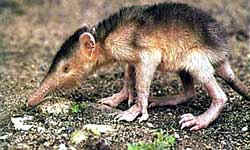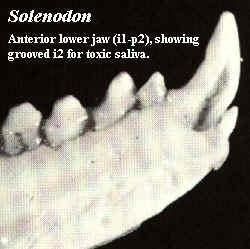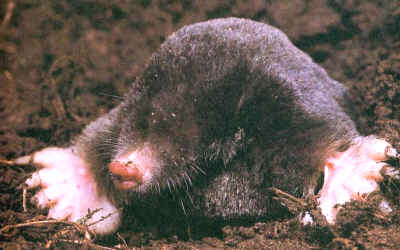
| Palaeos |  |
Insectivora |
| Vertebrates | Soricomorpha |
| Page Back | Unit Home | Unit Dendrogram | Unit References | Taxon Index | Page Next |
| Unit Back | Vertebrates Home | Vertebrate Dendrograms | Vertebrate References | Glossary | Unit Next |
|
Abbreviated Dendrogram
EUTHERIA | |--INSECTIVORA | |--Chrysochloroidea | `--+--Erinaceomorpha | `--Soricomorpha | |--Tenrecoidea | `--+--Solenodontidae | `--+--Talpoidea | `--Soricoidea | |--Apternodontidae | `--Soricidae | |--Crocidurinae | `--Soricinae `--+--Chrysochloroidea `--AFROTHERIA |
Contents
Index |
 Soricomorpha:
Otlestes?
Soricomorpha:
Otlestes?
Range: originally tentatively considered from the Late Cretaceous?, now from the Early Paleocene
Phylogeny: Insectivora::: Erinaceomorpha + *: Tenrecoidea + (Solenodontidae + (Talpoidea + Soricoidea))
Characters: head small [A+02$]; alisphenoid canal elongate & continuous anteriorly with exit foramina of ophthalmic or facial divisions of Vth nerve [A+02$]; dentary with angular process at posteroventral corner narrow & without taper [A+02$]; P4 parastyle on mesiobuccal margin projects mesially at a sharp angle [A+02$]; M1 parastyle on mesiobuccal margin projects mesially at a sharp angle [A+02$].
Links: Soricomorpha (Mikko's Phylogeny); Eurasian Insectivores and Tree Shrews - Status Survey and ... (taxonomic history); Molecular evidence for multiple origins of Insectivora and for a ... (molecular maundering); Untitled (more sensible approach); Mammalian mitogenomic relationships and the root of the eutherian ... (no comment); Mitogenomic analyses of eutherian relationships (ditto); pal2 (list of Paleocene species).
References: Asher et al. (2002) [A+02]. ATW030727.
 Tenrecoidea:
(tenrecs) Echinops, Geogale, Hemicentetes, Limnogale, Microgale,
Micropotamogale, Oryzorictes,
Potamogale, Tenrec.
Tenrecoidea:
(tenrecs) Echinops, Geogale, Hemicentetes, Limnogale, Microgale,
Micropotamogale, Oryzorictes,
Potamogale, Tenrec.
Range: from the Eocene of North America and Miocene of Africa [N99]. Currently Madagascar and parts of West Africa [N99].
Phylogeny: Soricomorpha:: (Solenodontidae + (Talpoidea + Soricoidea)) + *.
Characters: shrew to rabbit size (4-40 cm) [N99] [V+00]; snout usually long & slender [V+00]; maxilla with long posterior process extending past tooth row along ectopterygoid margin [A+02$]; maxilla not ventrally convex along tooth row [A+02$]; nasals long & narrow [N99]; lacrimal foramen small [A+02$]; orbits small [V+00]; jugal absent [V+00]; pinnae conspicuous [V+00]; tympanic annular [V+00]; tympanic roof lacks vidian foramen for vidian branch of carotid [A+02$]; squamosal roofs much of tympanic cavity [V+00]; basisphenoid with tympanic process contributing to anterior wall of bulla [A+02$]; stapedial artery passes through foramen in alisphenoid contribution to anterior wall of middle ear [A+02$]; cerebrum smooth [M+00]; braincase not constricted between orbits [N99]; mesial dentition quite variable [V+00]; P1 always absent [N99] [V+00]; P3 mesiodistally longer than P2 [A+02$]; p3 prominent cusp on mesial margin [A+02$]; molars 2-4/2-3 [V+00]; upper molars tricuspid & triangular (zalambdodonty), but W-shaped ectoloph (dilambdodonty) present in Potamogale [V+00] (contra [A+02]: Potamogale is zalambdodont); M1 without mesially projecting parastyle [A+02$]; clavicle present (except Potamogale) [N99]; tail extremely variable, with some almost tailless while Microgale has 47 caudal vertebrae [N99]; cloaca present [V+00].
Note: [1] Adaptive radiation in Madagascar to fill all usual insectivore roles, with much morphological convergence. Potamogale, an otter-like aquatic form, and the smaller and less specialized Micropotamogale, have a highly disjunct distribution. They are found only in West and West Central Africa. [N99]. [2] Note the extreme generality and plasticity of this form. This may simply be due to its long isolation in Madagascar. On the other hand, it may be that tenrecs are a bit closer to the eutherian root than even the erinaceomorphs.
Links: Tenrecoidea (Mikko's Phylogeny); Mitogenomic analyses of eutherian relationships (are afrotherians); Eurasian Insectivores and Tree Shrews - Status Survey and ... (taxonomic history); Anatomy of the oro-nasal region of some species of Tenrecidae and ... (abstract); 食虫目 (Chinese: brief discussion of phylogeny); Echinops telfairi (are the sister group of elephants ... right).
References: Asher et al. (2002) [A+02]; Mouchaty et al. (2000) [M+00]; Nowak (1999) [N99]; Vaughan et al. (2000) [V+00]. ATW030721.
 Solenodontidae:
Solenodon. May also include Nesophontes; but current view is
that this is a separate and distantly related group.
Solenodontidae:
Solenodon. May also include Nesophontes; but current view is
that this is a separate and distantly related group.
Range: from the Pleistocene of the Caribbean [V+00].
Phylogeny: Soricomorpha::: (Talpoidea + Soricoidea) + *.
Characters: Head and body 28-32.5 cm, with tail 17.5-25.5 cm and
weight ~1 kg [N99]; general appearance as large, stout shrews [N99] [V+00]; head
very large [A+02$]; skull long, slender;
snout long,
bare-tipped, supported at the base by a small round neomorphic os proboscidis
[N99];
snout highly flexible & nearly hairless [V+00]; rostrum shows muscle scars
corresponding to well muscled proboscis [A+02]; nares open laterally [N99]; eyes
small [N99] [V+00]; skull nearly flat & constricted between orbits [N99]; lambdoid crest on the dorsal surface of the cranium, projects
eave-like over occipital region [N99]; incomplete zygomatic arch;
jugal absent; auditory bulla absent; pinnae prominent [N99] [V+00]; dentary with
angular process at posteroventral corner broad & tapering [A+02$]; dentary condyle
transversely expanded? [C88]; deciduous teeth replaced very early [C88]; dental  formula 3/3, 1/1, 3/3, 3/3 [V+00]; I1 large and points slightly posteriorly [V+00];
diastema between I1 & I2 [N99]; i2 with deep groove for injection of toxic saliva, used as
venom [N99] [V+00] [A+02$]; i2 trenchant & larger than other incisors
[A+02$]; p3 with distinct cusp on distal margin [A+02$]; molars V-shaped, &
primary cusp is paracone (zalambdodont)
[A+02] [C88];
molars with tall, trenchant buccal ridge [V+00]; upper molars basically
tricuspidate [V+00] (contra [A+02$: M1 & M2 with prominent
hypocone); M3 paracone occludes with a basin between m3 hypoflexid & a
cingulid [A+02$]; m2 mesial cingulid does not extend to buccal margin
[A+02$]; m3 ?mesiodistally longer than other molars [A+02$]; tail nearly hairless [V+00]; feet large, clawed, 5/5, with claws larger
& more curved on
forelimbs [N99] [V+00]; tibia & fibula may fuse distally in older
individuals [N99]; scent glands in armpit & groin [N99]; separate anal and
urogenital openings [N99]; feed on animals (including insects), but also sometimes plant
material [V+00]; root in ground with snouts or tear up rotten logs with claws
[N99]; found in
forests or brush, mainly nocturnal [N99] [V+00]; walk with awkward gait, digitigrade; incapable of jumping; can
run surprisingly fast & can climb; some extensive tunnel systems in deep
humus [N99]; may be social [1], with young
sometimes remaining with the parents while subsequent litters are born and
raised; stable dominance relationships [N99]; high-frequency (9-31 kHz) vocalizations may be used in echolocation
[N99] [V+00].
formula 3/3, 1/1, 3/3, 3/3 [V+00]; I1 large and points slightly posteriorly [V+00];
diastema between I1 & I2 [N99]; i2 with deep groove for injection of toxic saliva, used as
venom [N99] [V+00] [A+02$]; i2 trenchant & larger than other incisors
[A+02$]; p3 with distinct cusp on distal margin [A+02$]; molars V-shaped, &
primary cusp is paracone (zalambdodont)
[A+02] [C88];
molars with tall, trenchant buccal ridge [V+00]; upper molars basically
tricuspidate [V+00] (contra [A+02$: M1 & M2 with prominent
hypocone); M3 paracone occludes with a basin between m3 hypoflexid & a
cingulid [A+02$]; m2 mesial cingulid does not extend to buccal margin
[A+02$]; m3 ?mesiodistally longer than other molars [A+02$]; tail nearly hairless [V+00]; feet large, clawed, 5/5, with claws larger
& more curved on
forelimbs [N99] [V+00]; tibia & fibula may fuse distally in older
individuals [N99]; scent glands in armpit & groin [N99]; separate anal and
urogenital openings [N99]; feed on animals (including insects), but also sometimes plant
material [V+00]; root in ground with snouts or tear up rotten logs with claws
[N99]; found in
forests or brush, mainly nocturnal [N99] [V+00]; walk with awkward gait, digitigrade; incapable of jumping; can
run surprisingly fast & can climb; some extensive tunnel systems in deep
humus [N99]; may be social [1], with young
sometimes remaining with the parents while subsequent litters are born and
raised; stable dominance relationships [N99]; high-frequency (9-31 kHz) vocalizations may be used in echolocation
[N99] [V+00].
Notes: [1] this is fairly unusual for insectivores, but is also found in some tenrecs.
Image: Right: Solenodon from APUS.RU | Щелезуб гаитянский (which has several other nice images). Left: lower jaw detail from Solenodon. Note that image is upside-down on that page.
Links: Solenodontidae Family (ADW; very good anatomical summary, with excellent images); APUS.RU | Род ĚЩелезубы - Solenodon (Russian: similar to previous site, with some additional information); SchlitzrŘ▀ler (German: seems to have interesting notes on behavior); Solenodon; The Haitian or Hispaniolan Solenodon / Solenodon paradoxus (excellent page on the very rare S. paradoxus); Gallery of Incisors (ADW: what it says).
References: Asher et al. (2002) [A+02]; Carroll (1988) [C88]; Nowak (1999) [N99]; Vaughan et al. (2000) [V+00]. ATW030728.
 Talpoidea:
desmans, moles & shrew moles. Hesperoscalops. A rarely used clade, but useful to
describe moles > hedgehogs, reserving "Talpidae" for the crown
group of living moles (17 genera & ~35 species). At the moment, we
actually draw no distinction, so all this erudition is wasted.
Talpoidea:
desmans, moles & shrew moles. Hesperoscalops. A rarely used clade, but useful to
describe moles > hedgehogs, reserving "Talpidae" for the crown
group of living moles (17 genera & ~35 species). At the moment, we
actually draw no distinction, so all this erudition is wasted.
Range: from the Eocene of North America, Europe, Russia, Siberia, Central Asia & China; possibly South and Southeast Asia. Fossorial adaptations from the Miocene.
Phylogeny: Soricomorpha:::: Soricoidea + *.
Characters: head + body 6-22 cm [N99]; rostrum long, tubular,
naked, extending beyond margin of lower lip [N99]; rostrum
(and manus) with high density of Eimer's organs (very sensitive touch receptors)
[V+00]; eyes very small or covered with skin [N99] [V+00]; zygomatic arch complete [V+00]; pinnae usually absent
[N99] [V+00]; bulla incomplete
[V+00]; dentary condyle not transversely expanded [C88]; dentition 2-3/1-3, 1/0-1, 3-4/3-4, 3/3 [V+00];
I1 flat, without elongate crown [N99]; I1-2 inclined back
[V+00]; upper molars with W-shaped ectolophs (dilambdodont) [C88] [N99] [V+00];
neck short [N99]; body generally cylindrical and elongate [N99]; sternum deeply
keeled in burrowing forms [N99]; manubrium
extended anteriorly below skull (increases attachment for pectoralis
and moves shoulder anteriorly) [V+00]; clavicle short & robust [V+00];
clavicle providing  secondary articulation for humerus, bracing humerus during
rotation for digging motion [V+00]; scapula long &
slender, anchoring forelimbs against axial skeleton & for origin of
retractors [V+00]; humerus short & robust [V+00]; massive humerus receives
radius in an S-shaped cavity, so that forelimbs are rotated with digits point laterally, palms ventral, & forelimb is almost vertical [V+00];
digits 5/5 [N99]; falciform
may be enlarged to brace
digit I more strongly against forearm [V+00]; phalanges short, unguals long;
terminal phalanx with longitudinal groove or bilobed [N99] [2]; tibia
& fibula fused distally [N99]; fur fine, soft, and of same length, without
preferred orientation (but desmans also have long, oily specialized guard hairs)
[N99] [V+00]; sensitive hearing, particularly low vibrations [N99]; two tunnel
types: shallow tunnels pushed up with back & deeper permanent tunnels [N99];
rapid diggers, even in hard soil [N99]; several aquatic species which burrow
only incidentally [N99]; usually, but not always solitary [N99].
secondary articulation for humerus, bracing humerus during
rotation for digging motion [V+00]; scapula long &
slender, anchoring forelimbs against axial skeleton & for origin of
retractors [V+00]; humerus short & robust [V+00]; massive humerus receives
radius in an S-shaped cavity, so that forelimbs are rotated with digits point laterally, palms ventral, & forelimb is almost vertical [V+00];
digits 5/5 [N99]; falciform
may be enlarged to brace
digit I more strongly against forearm [V+00]; phalanges short, unguals long;
terminal phalanx with longitudinal groove or bilobed [N99] [2]; tibia
& fibula fused distally [N99]; fur fine, soft, and of same length, without
preferred orientation (but desmans also have long, oily specialized guard hairs)
[N99] [V+00]; sensitive hearing, particularly low vibrations [N99]; two tunnel
types: shallow tunnels pushed up with back & deeper permanent tunnels [N99];
rapid diggers, even in hard soil [N99]; several aquatic species which burrow
only incidentally [N99]; usually, but not always solitary [N99].
Notes: [1] live in moister soils with permanent tunnel systems. [2] Unclear whether this applies to pes.
Image: right: from Gli Insettivori. Left: modified from [V+00].
Links: Basal Talpoidea (Mikko's Phylogeny).
References: Carroll (1988) [C88]; Nowak (1999) [N99]; Vaughan et al. (2000) [V+00]. ATW030718.
| Page Back | Unit Home | Page Top | Page Next |
checked ATW050623